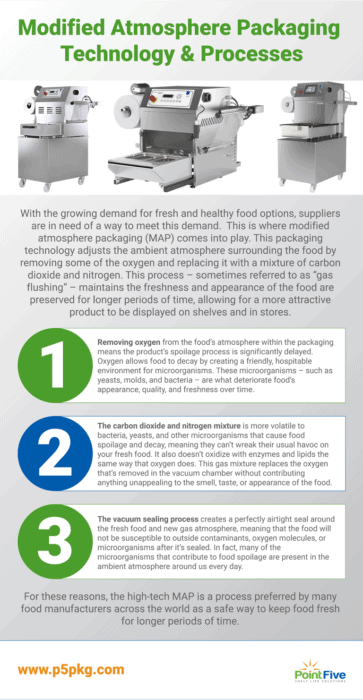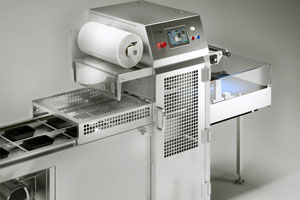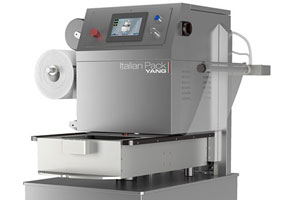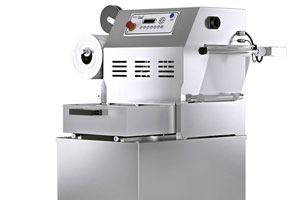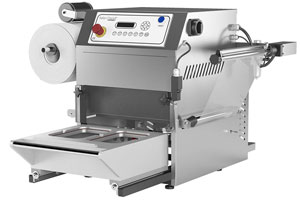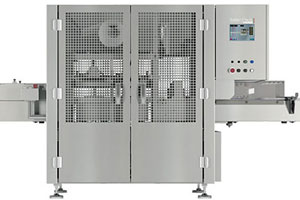Modified Atmosphere Packaging Technology & Processes
With the growing demand for fresh and healthy food options, suppliers are in need of a way to meet this demand. This is where modified atmosphere packaging (MAP) comes into play. This packaging technology adjusts the ambient atmosphere surrounding the food by removing some of the oxygen and replacing it with a mixture of carbon dioxide and nitrogen. This process – sometimes referred to as “gas flushing” – maintains the freshness and appearance of the food are preserved for longer periods of time, allowing for a more attractive product to be displayed on shelves and in stores.
Removing oxygen from the food’s atmosphere within the packaging means the product’s spoilage process is significantly delayed. Oxygen allows food to decay by creating a friendly, hospitable environment for microorganisms. These microorganisms – such as yeasts, molds, and bacteria – are what deteriorate food’s appearance, quality, and freshness over time.
Removing some oxygen also stops some reactions from occurring between oxygen molecules and the fatty lipids in food. These lipid reactions are responsible for many of the sensory signals that indicate to us that food has gone bad, such as “off” flavors. Similarly, enzymes that naturally occur in food can oxidize when they’re exposed to oxygen for a long period of time. This also contributes to unappealing food spoilage, including fresh veggies going brown and smells turning sour. Not all of the oxygen from the packaging is removed; usually, keeping somewhere between 0.5% – 2.5% oxygen is sufficient, and the oxygen that is removed is replaced with a carbon dioxide and nitrogen mixture.
The carbon dioxide and nitrogen mixture is more volatile to bacteria, yeasts, and other microorganisms that cause food spoilage and decay, meaning they can’t wreak their usual havoc on your fresh food. It also doesn’t oxidize with enzymes and lipids the same way that oxygen does. This gas mixture easily replaces the oxygen that’s removed in the vacuum chamber without contributing anything unique or unappealing to the smell, taste, or appearance of the food.
The vacuum sealing process creates a perfectly airtight seal around the fresh food and new gas atmosphere, meaning that the food will not be susceptible to outside contaminants, oxygen molecules, or microorganisms after it’s sealed. In fact, many of the microorganisms that contribute to food spoilage are present in the ambient atmosphere around us every day. This last step of the MAP process seals in the new atmosphere and simultaneously protects the food from external contamination.
For these reasons, the high-tech MAP is a process preferred by many food manufacturers across the world as a safe way to keep food fresh for longer periods of time.
How Do MAP Packaging Machines Protect Food?
MAP protects food by shielding it from oxygen and outside moisture. This ensures that oxygen can’t prematurely age the food and that moisture can’t cause spoilage or encourage the growth of bacteria.
In MAP machinery, this is done by balancing the atmosphere inside each package so that pressure and volume are appropriately maintained without damaging the package or the product.
- Depending on the type of machine, the product may be automatically brought down a conveyor belt that brings them to a sealing chamber or packages may be manually placed into the sealing chamber.
- The vacuum pump removes most of the atmosphere from the package and replaces it with a gas mixture, usually a carbon dioxide and nitrogen mixture.
- In the sealing chamber, plastic film is heat-sealed over the top of the tray to seal in the gas mixture.
- The plastic film is cut to size and the sealed product is released from the chamber.
Types of MAP Packaging Components
Plastic Food Trays
The trays used in MAP processes are chosen for their durability and ability to withstand the vacuum sealing and packaging process. These trays are a critical component in ensuring all of the hard work done to create the proper atmosphere for food is not undone by breakage or leakage.
Ideal trays for MAP packaging are:
- Made of durable plastic, such as CPET and PP
- Strong enough for packaging, shipping, and display
- Leak-proof and spill-proof
- Microwave-safe or ovenable (if used for ready meals)
Barrier Packaging Films
Some container and packaging films are better than others. Poorly insulated plastics allow moisture and oxygen to seep through the packaging over time, even when it’s sealed. But other plastics create a more resistant barrier. They can even hold indicators that alert warehouses and retailers about potential spoilage, unsafe temperature exposures, and leaks.
Most high barrier films are multi-layered structures, combining a couple of plastics to achieve the barrier. Some of the plastics commonly utilized for barrier packaging film include:
- Low-density polyethylene (LDPE)
- Polypropylene (PP)
- Polyvinyl chloride (PVC)
- Amorphous polyethylene terephthalate and polyethylene terephthalate (APET/PET)
Scavenger or Desiccant Packs
When it’s impossible to block all moisture or oxygen from being present in a package before sealing, desiccant packs can help mitigate the effects by absorbing moisture and oxygen. These sachets include activated carbon, ascorbic acid, and iron powder in different combinations to best protect the food contents of a package.
On-Package Valves
One-way valves can continue to allow gases to escape a food package long after sealing, without the risk of allowing oxygen into the package. This can release pressure in the event that the product degases after packaging and allows the containers to be flattened during stacking and shipping.
Why Use a MAP Packaging System?
You should consider a MAP system for your products because of the cost savings and consumer benefits. With selling fresh foods comes the risk of spoilage and any product the spoils cannot be sold. A MAP system extends the shelf life of your products.
The initial investment into a MAP system will easily be recouped through the benefits you’ll notice in your food products:
- Extended shelf life
- Less food waste/spoilage
- Reduced plastic waste
- Better on-shelf appearance
- Flexible machinery systems
MAP technology is recommended for a wide variety of foods, but it is especially useful for foods that are quick to spoil or change appearance, such as:
- Fresh fruits and vegetables
- Pre-cut fruits and vegetables
- Raw meat
- Cooked meat
- Dairy products
- Ready meals
- Bakery goods
Benefits of Point Five Packaging’s MAP Packaging Machinery
When it comes to MAP Packaging technology, there are a variety of benefits that Point Five Packaging’s machines are capable of providing to its customers:
- Capable of tray and cup sealing, modified atmosphere (MAP), vacuum-gas or vacuum skin packaging (VSP)
- Compact footprints and tabletop model options available
- Budget-friendly options available
Our machinery is used by both small start-up businesses and large manufacturers; we can help you find the perfect solution for your business!
MAP Packaging Solutions from Point Five Packaging
At Point Five Packaging, we offer the complete packaging solutions you need for specialty products and projects. Our company is uniquely qualified to provide high-quality MAP packaging solutions. Since 2010, we have been creating food packaging, atmosphere packaging, and a network of reliable delivery resources. Contact us today to learn more about our packaging solutions or request a quote for detailed pricing.
P5-A Fully Automated Packaging System
The P5-A fully automatic seal system is ideal for any food production and packaging environment. Configurable for manual feed or fully automatic production, the P5-A can produce vacuum-gas flushed MAP containers, vacuum skin packs (VSP) and seal-only trays. In full automatic mode, the P5-A can be tailored to customers’ needs and customized with lane dividers, extended infeeds with integrated automatic tray denesters, filling and depositing systems, lid applicators lane merging systems. All the components allow for a turnkey “complete line” to meet the requirements of today’s food industry.
The P5-A is capable of production rates of up to 60 sealed trays per minute, 32 MAP trays and 28 skin trays. An optional seal head storage cart ensures that tooling can be changed over in less than 5 minutes. The user-friendly touch screen display allows easy for simple and quick product set up and storage of up to 99 product recipes and language selection including English, Spanish and French. Film sealing, MAP and vacuum skin packing can all be achieved on the same seal head.
P5-RM Semi-Automatic Packaging System
Step it up a notch with the P5-RM from Point Five Packaging. This semi-automatic tray seal system is capable of producing vacuum, MAP (vacuum gas), vacuum skin packing (VSP) and sealing of pre-formed trays and cups. The manual turntable operation considerably cuts cycle times and optimizes output. It allows the operator to load and unload trays at one station while the machine is performing a seal operation at the other. When ready, the operator will rotate the table and the cycle begins again.
The P5-RM is fitted with easy to load film rack and automatic film advance. An optional print registered film operation and an automatic tray lifter for easier loading/unloading. The P5-RM can run up to 16 MAP trays, 28 sealed trays and 12 vacuum skin pack trays per minute. Quick change seal heads can be changed out in less than 2 minutes. A user-friendly touch screen display allows easy product set-up, storage of up to 99 product recipes and multiple language selection including English, Spanish and French.
P5-M Semi-Automatic Packaging System
The P5-M seal system combines a robust design with compact footprint to deliver the ultimate entry level to tray and cup sealing, modified atmosphere, vacuum-gas or vacuum skin packaging. A stainless steel sanitary construction ensures the P5-M is at home in any food packaging environment. The P5-M is ideal for small and medium packers and is a handy addition and backup system for large producers as well. Versatile and compact with an attractive price tag, the P5-M is well suited for R&D labs in academic, medical, agricultural and food packaging research centers.
P5-T Semi-Automatic Packaging System
The P5-T table top seal system is the perfect solution for sealing trays and cups and also creating vacuum-gas sealed modified atmosphere (MAP) and/or vacuum skin packs (VSP) with a minimal investment. Ideal for any entry level or production re-work operations, the P5-T is also well suited for retail or laboratory environments. A user friendly, color touch screen with multiple product recipes, an easy to load film rack and automatic scrap film rewind and a quick change seal heads are all standard features of this handy system.
P5-4ZA Automatic Packaging System
The P5-4ZA series is a fully automated tray and cup seal system capable of producing vacuum-gas MAP packs, vacuum skin packs (VSP) and/or no MAP sealed trays and cups. The P5-4ZA can be equipped with up to 3 sealing stations to achieve production rates of up to 150 trays per minute (no MAP). Customers can also choose to run different products at each seal station and significantly reduce their change over time. Seal head changeover can be accomplished in under 5 minutes with an optional ergonomically efficient seal head storage cart.
The P5-4ZA can be customized for your specific packaging line layout and integrated with a variety of options and components to create a fully turnkey packaging line. Point Five Packaging will assist you by conceptualizing, designing and developing infeed and outfeed conveyor lines, tray denesters, fillers and depositors, markers/printing machines, aligning devices, etc. The userfriendly color touch screen display allows easy product set up and change over and can store up to 99 product programs. Operators may also choose between English, Spanish and French screen translations.


